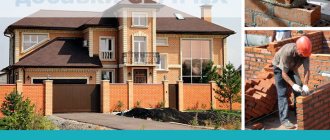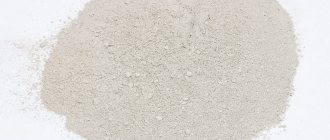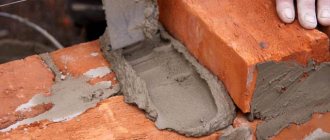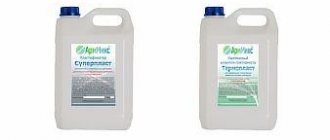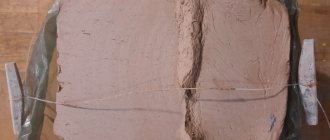From time immemorial, clay has been actively used by mankind in construction work, because even in ancient times it was noticed that under the influence of fire, clay becomes strong enough to withstand loads and mechanical stress. Today, clay is classified into different grades depending on its distinctive properties. So, for example, fireclay clay is actively used for finishing stoves, fireplaces and other surfaces exposed to high temperatures - you can mix such clay with your own hands even at home, and the base for its preparation can be purchased at any large construction supply store.
What is needed for cooking
To make fireclay clay with your own hands you will need:
- dry chamotte clay powder;
- water;
- high capacity;
- trowel or straight stick for stirring.
As a rule, the base for fireclay clay is produced in the form of a powder that must be diluted with water. At the same time, the powder itself is afraid of exposure to moisture, so fireclay clay should be prepared with your own hands in a short period of time so that the powder does not set prematurely. If you have time to thoroughly mix the mixture of powder and water, you will get a homogeneous mass that can be easily applied to the surface. When preparing the solution, experts recommend adding a small amount of glue to the mixture, which will give it additional strength.
Master class on making designer ceramic tiles
Ceramic tiles, created according to an individual design by hand shaping, always reflect the individuality of the author. Bright or delicate colors of painting, the embodiment of your own decorative ideas will allow you to create a unique piece of decorative and applied art. At a master class in our workshop you will create ceramic tiles of your own design, embody your personal creative ideas and realize artistic plans. Since the dimensions of the tile are 10*10 cm, it can be used in the design of your own space or as a hot stand. Elegant stylistic solutions will allow such an object to fit into any interior.
Cooking process
In general, the process of preparing a solution of fireclay clay is technologically simple; even a novice finishing master can cope with it. To do this, you need to take packaged powder for preparing fireclay clay, pour it into a tall container and add a little water. The main thing is not to overdo it with water, otherwise the solution will turn out to be too liquid and will not stick to the surface being treated. It is also necessary to take into account that a high-quality solution for preparing fireclay clay must be infused in water for several days, however, today manufacturers add chemical compounds to the powder composition that ensure accelerated preparation of the solution.
In essence, this is artificial fireclay clay, but compositions for accelerated preparation of fireclay clay are in high demand. The main thing here is not to purchase cheap compounds, because the lower the price of the solution, the lower its quality. Accordingly, the more additives in the powder for preparing fireclay clay, the higher its cost should be.
When preparing fireclay clay with your own hands. It is important to ensure constant mixing. If you don't stir, the powder will clump and not mix completely. When the time comes to apply the solution to the surface, lumps will become a noticeable problem for quality work. To be on the safe side, you need to remember that fireclay clay, ready for application, should have a consistency similar to thick sour cream, and not milk or kefir. Therefore, it is important to correctly calculate the ratio of water and dry solution, otherwise all the work will go down the drain and the material will be wasted. If you need to prepare a solution of fireclay clay, then you need to purchase a special powder for instant preparation of fireclay clay. With its help, the cooking time is reduced significantly, but it also requires quick actions - otherwise it will simply stick together.
When finishing surfaces, fireclay clay is applied with your own hands as easily as it is prepared. It is applied to the surface with a spatula, leveled, and left until completely dry. Once the clay is dry, it can be sanded with soft, fine sandpaper. After this, finishing the surface with fireclay clay is completed.
Tile molding
Next, you can begin to form the tiles. For comfortable work, it is better to use polyurethane molds. For small batches, gypsum ones are also quite suitable. Forms will help to make smooth products that have the same external data. This requires careful compaction of the clay and its proper distribution according to the existing shape. The same thickness must be maintained over the entire area of the template.
After this work, the workpiece (raw material) must be thoroughly dried. The required degree of drying will be achieved when the tiles lighten and harden. It is very important to be careful here, since the raw material is quite fragile at this stage. But if any defect occurs, molding and drying can be repeated. To do this, the workpiece can be soaked in water.
Composition of fireclay clay
The main component of fireclay clay mortar is burnt kaolin (fireclay). Kaolin is a natural clay, sedimentary rock. This is a very viscous, plastic material .
Kaolin clay is composed of kaolinite . The chemical formula of this mineral is Al4[Si4O10](OH)8 . Clay contains impurities :
- oxides of potassium, magnesium, calcium, sodium;
- hydroxides of iron, titanium and their sulfides.
Kaolinite is fired at a temperature of 1300-1850 degrees Celsius . When heated, bound water is removed from the mineral formula and fireclay is obtained. During the beneficiation and roasting process, sulfides and hydroxides of titanium and iron are removed.
The fired mass is partially sintered and loses its plasticity; after heat treatment, the material acquires its main quality - fire resistance . Pieces of the resulting fireclay are crushed to a finely dispersed state and to crushed stone with a fragment size of 0.5-2.5 mm . Depending on the firing technology, two types of fireclay are obtained:
- highly annealed (water absorption - from 2 to 10% water );
- low-annealed (water absorption - up to 25% water ).
Reference. Regular clay contains not only kaolinite, but also other clay minerals. The amount of constitutional water reaches 14% . The low (compared to fireclay) heat resistance of ordinary clays is associated with their heterogeneous composition and a large amount of bound water.
Applying glaze
Your tiles need to be shined. To do this, you can prepare your own special glaze. It may consist of glass, kaolin and tripolyphosphate. These components produce a dust-like powder. It must be mixed with clean water. Other minerals can be added to this mixture. The general list includes about 30 species.
The prepared glaze is applied to the tile using one of three methods (or combinations thereof): spray, brush, or pour-over method.
The coating must harden thoroughly and bond to the terracotta. To do this, it undergoes secondary firing. It is important here that the ceramic mass does not reach a critical value according to temperature data. Otherwise the tile will melt. Glaze will allow you to create unique and elegant artistic solutions.
Characteristics. Why is this good for laying stoves?
Fireclay clay mortars are ideal for laying fireclay bricks, since the brick and the binding paste have the same coefficient of linear expansion .
When heated, such masonry expands evenly and cracks do not form in the seams.
Fireclay mortar is also suitable for laying ceramic bricks. The characteristics of fireclay clay that make it suitable for kiln construction include:
- High heat resistance (the fired solution does not crack at a temperature of 1300-1850 degrees , depending on the initial characteristics of fireclay).
- High adhesion ( transfers water well to ceramic and fireclay bricks and adheres tightly to them).
- Strength in thin seams, which allows you to make masonry with a thickness of 3-5 mm .
- Strength in wide vertical joints (fireclay clay can be used to fill gaps up to 12 mm wide ).
Important. The consumption of fireclay mortar for stove masonry depends on the thickness of the seams and is 20 kg per 50-100 bricks .
Where and for what is fireclay clay used?
Heat-resistant fireclay clay is used not only for the construction of household stoves. It is used for laying metallurgical and other industrial furnaces . Chamotte is a filler for refractory concrete.
The applied use of fireclay is also widespread. This material is used to make sculptures for the garden, stucco decorations for buildings, decorative ceramics, panels and clay souvenirs, and pottery .
Vessels made from fireclay are durable and elegant. Potters make lightweight jugs, vases, and bowls with thin walls from fireclay clay. The fired dishes produce a melodious, pleasant ringing sound, similar to the ringing of a crystal vessel.
How to choose quality clay
Fireclay clay called “Kaolin” and ready-made mixtures are sold in construction stores . There are good reviews about both Russian and foreign manufacturers of this heat-resistant material. The best is considered fireclay produced at Western European .
When choosing materials, pay attention to the year of production and its quality . A high-quality mixture and clay do not contain particles exceeding the fraction size indicated on the packaging.
The mixture for preparing the solution should not contain crushed stone or sand larger than 2.5 mm.
The letter “U” on the package indicates that the fireclay is made from recycled, recycled material. The letter “Ш” means that the material has not been recycled, it is better suited for laying the firebox.
Construction materials are stored in specially equipped warehouses. If fireclay is stored in a dry room, in sealed bags, at a temperature from plus 40 to minus 40 degrees , then the shelf life of mixtures and clays is unlimited. Long-term storage ( more than three years ) in conditions of high humidity will lead to deterioration of the properties of the material due to moisture saturation.
Mistake 2. Poor quality sand
Often, in order to save money, summer residents bring sand from a nearby quarry and immediately use it. But in order to obtain a quality product, a visual assessment of the materials used is not enough. The sand must be sifted. Otherwise, the heterogeneous components included in its composition can greatly complicate your life. For example, small shells settle on the front side of the tile and spoil its design. If they remain inside, they are often not completely filled with concrete mixture. Subsequently, the tiles actively absorb water, which accumulates in the voids and, when temperatures fluctuate, destroys the concrete from the inside.
Unsifted sand cannot be used to prepare the mortar; this leads to the appearance of defects on the surface of the tile and its further cracking
If there were lumps of clay in the sand, which then fell into the concrete mixture, then they most likely will not dissolve completely, but during the manufacture of tiles they will hide under a thin layer of cement. When laying or using such tiles, as a rule, they burst.
How to properly prepare a clay solution
Fireclay clay is soaked . The material is poured with water so that it completely covers the clay powder. The ingredients are thoroughly mixed so that there are no lumps or dry clay left in the corners of the vessel. The container is hermetically sealed and left for three days .
Manufacturing steps: dilute the mixture for construction with your own hands
For preparation you will need a large vessel, cold water, a stirrer, a mixer, fireclay clay , fireclay sand (crushed stone) or quartz sand . There are different recipes for fireclay compositions:
- 1 measure of fireclay clay, 2-4 measures of fireclay sand, crushed stone ;
- 1 measure of fireclay clay, 3-5 measures of quartz sand .
The amount of water is taken exactly in accordance with the instructions from the fireclay manufacturer. room temperature from plus 5 degrees and above ( up to plus 60 degrees ).
- Clay is poured into the container.
- Fillers (sand, crushed stone) are poured on top of the clay.
- Pour water over the dry ingredients.
- The mass is mixed with a spatula or a construction mixer.
- The container is closed to avoid excessive evaporation of water and left for three days .
- After the specified time, the paste is thoroughly mixed again and the laying begins.
Reference. Ready-made fireclay mixtures are diluted according to the manufacturer’s recommendations. Complex compositions , which include chemical additives, fiberglass, heat-resistant adhesives, plasticizers, cement, do not require long-term soaking. Such solutions are ready for use within 20-25 minutes after mixing.
So, to prepare for work “Heat-resistant clay-clay fire masonry mixture” from the manufacturer Terrakot , you will need a container, a mixer, a stirrer , and clean cool water . Take 240 ml of water per kilogram of powder, according to the instructions on the package.
- The mixture from the bag is poured into the tank.
- Water is poured into the vessel, the solution is mixed with a spatula and a mixer.
- The paste is kept for 20 minutes , mixed again and used for masonry. If necessary, add a little water to achieve the desired consistency of the solution.
Scope of application
Fireclay can be used alone or mixed into plaster solutions. Fireclay is not only thermally resistant, but has deep brown and brown shades and an impressive texture. Aesthetic qualities significantly expand the scope of application of the material:
- production of construction refractories;
- interior design using fireclay plaster;
- casting and sculpting of souvenirs, dishes, figurines;
- preparation of solutions for the construction of stoves and fireplaces;
- for the formation of heat-insulating screens.
For designers, sculptors, craftsmen, and decorators, refractory clay opens up endless possibilities. You can add various fillers and dyes to it. The plastic material can take on the most intricate shapes. The spectacular texture brings an element of uniqueness. In construction and renovation, fireclay is characterized by local use.
Decorating the walls of premises with fireclay plaster
Methods for checking the quality of the resulting substance
The consistency of well-prepared clay paste resembles sour cream. The plasticity of the finished mixture is checked in one or more ways.
- The solution is taken with a trowel or spatula and tilted at an angle of 45 degrees . A normal solution does not flow from the trowel, does not fall from it in lumps, but remains on the working surface of the tool.
- The solution is applied to the brick in an even layer (5 mm) and dried . If the composition is “lean” (contains excess sand), then after drying the paste crumbles off the brick with light mechanical stress. After drying, the greasy solution will become covered with cracks; it contains a lot of clay and little sand. Normal paste hardens in an even layer without cracks . It does not crumble, does not crumble, does not crack.
Photo 1. Method for checking the quality of the mortar: on the first brick the dried mixture crumbles, on the third it cracks, the best consistency is on the second.
- The plasticity of the finished mixture is checked with a flagellum . Roll out a “sausage” from the solution with a diameter of 1.5-2 cm and a length of up to 20-22 cm . The flagellum is slowly stretched and wrapped around a cylindrical object. A less flexible strand of thin clay will immediately break. A flagellum made from a fatty mixture will stretch strongly and stick to the surface. A rope made from a solution of normal composition will break when stretched when its diameter decreases by approximately 20% .
What to do if the solution has dried out and turned out to be the wrong consistency?
If the solution is too thick (the consistency is thicker than sour cream), add water to it and stir thoroughly .
If the solution is liquid (drains from the spatula), all the ingredients (clay, sand) are added to it in the previously selected proportions and also mixed .
The mixture , without adhesive additives and cement, retains its qualities after drying . It needs to be filled with water and soaked. If the paste is completely dry, soaking will last several days.
If the solution contains chemical additives , cement and adhesives, then the dried solution cannot be soaked (like, for example, mortar). The manufacturer indicates this information on the packaging.
Mistake 5. Refusal of plasticizer
Of course, you can make tiles without it. But in conditions of unstable climate and temperature fluctuations, this is risky. The plasticizer helps make the solution more homogeneous, distribute the coloring pigment more evenly (when used), increase the strength and frost resistance, as well as the water-repellent properties of the products. In addition, it allows you to reduce the consumption of cement and water and, in some cases, do without a vibrating table, because compositions based on many plasticizers are self-compacting.
How long does clay mixture take to harden?
The time for complete drying of fireclay paste in air is 72 hours , inside the brickwork this time increases, it depends on the thickness of the masonry, temperature and humidity of the surrounding air. Petrification of fireclay mortar occurs at 800 degrees Celsius .
Important! Fireclay masonry does not like sudden changes in temperature.
for the first time three days after construction is completed. Use thin, quickly burning logs. The dampers and vents are fully opened during the first fire. Then the stove is dried for a week , burning small portions of wood daily.
Fireclay masonry dries faster than masonry made from ordinary clay-sand mortar and ceramic bricks, but only the firebox is usually made of fireclay. Therefore, the timing of the start of operation of a furnace with fireclay masonry will be the same as the timing of use of a furnace built on clay and lime mortar. In summer, a new stove is heated to maximum after 10-14 days, in winter - after a month .
Error 6. Lack of reinforcement in the manufacture of borders and large elements
When making large or elongated elements, such as curbs, many hope to do without the use of reinforcement. But in such cases, reinforcement is simply necessary. To do this, you can use a metal rod or mesh, as well as some types of wire.
The form is filled approximately halfway with the solution, then the reinforcing material is laid, which is filled with a second layer of solution.
If you don't use reinforcement, the curb will most likely have to be assembled from sloppy debris
Mineral composition
The raw material for the production of fireclay is clay, consisting of highly dispersed hydroaluminosilicates. In addition to them, the dry mass contains a certain amount of impurities. The extracted raw materials undergo a roasting procedure, after which they are enriched with minerals. There are many recipes that differ in the amount of water, fireclay powder and additives. The duration of heat treatment also varies. It depends on what characteristics the output product should have . The main difference is the colors and types of texture.
Chemical elements in refractory clay:
Main components
Fireclay fireproof kaolin clay is best suited for laying stoves
The clay composition varies depending on the components added:
- clay-sand;
- clay-cement;
- clay-lime.
Stove makers, as a rule, choose the first option. The proportions depend on what clay is used for the oven. If it is oily, the sand ratio will be 2:1, if it is medium oily it will be 1:1. Also, if the clay is of good quality, you can do without additives.
Features and Benefits
It is better to purchase fireclay clay not from hand or on the market, but from a specialized store. This way, there is less risk of buying low-quality products or those that were stored in inappropriate conditions. The fact is that low air humidity is very important for kaolin, otherwise it loses its unique properties and becomes as unstable to high temperatures as ordinary clay.
The production of fireclay clay is carried out in accordance with the requirements of GOST - 6137−8. According to this document, fireclay must have the following characteristics ;
- humidity - 5% or lower;
- water absorption for low-burnt fireclay is up to 25%, for high-burnt fireclay - up to 10%;
- average particle size - 2 mm;
- fire resistance limit - 1550−1850 ° C.
The material is sold packaged in bags of 5, 12.5, 20 and 50 kg. To lay 10-15 bricks, 10 kg of burnt kaolin is required, which is equivalent to 1 thousand kg per 1 cubic meter. m. Hardening of the solution occurs at air temperatures from +10 to +25 °C. Strengthening continues for 28 days.
Clay can be stored in its original packaging for 3 years from the date of production. Advantages of calcined kaolin:
- Fire resistance, allowing the product to be used for the construction of stoves, chimneys, fireplaces.
- Vapor permeability. The material allows excess moisture to pass through, maintaining an optimal microclimate in the room.
- Good adhesion. Chamotte-based plaster mortar adheres well to various surfaces.
- Safety for humans and the environment due to the fact that the composition contains only natural ingredients.
- Long service life. For several years, the clay does not crumble, crumble or crack.
There are only 2 disadvantages: the difficulty of preparing masonry mortar and the high cost compared to ordinary clay.
Material use options
Fire bricks are made from clay. It is used for the preparation of plaster and masonry mortars. The third application option is making crafts, souvenirs, and decorative dishes.
Heat resistant brick
This piece building material is sold ready-made. It will not be possible to make refractory bricks yourself at home, since it is difficult to maintain geometric accuracy and ensure the required firing temperature. Bricks for stoves are marked with the letter “Ш”. It is much more expensive than usual, so it is used only for laying the firebox. It is more profitable to make the rest of the furnace from ordinary ordinary bricks.
Masonry mortar is prepared from burnt kaolin, since it has the same coefficient of expansion as fireclay bricks. Solution consumption is about 30 liters per 100 pieces.
Plaster mixture
The plaster mixture is made from chamotte , just like from other dry raw materials. The consistency is like thick sour cream. The mixture is used for primary finishing, as well as for restoring areas where the putty has peeled off or cracked. Components for mixing the solution:
- 7 kg of quarry sand;
- 2 kg of fireclay clay;
- 1 kg of cement.
Take enough water to achieve the desired thickness. For application you need to use 2 spatulas, medium and wide. The solution is applied from bottom to top, leveling and picking up excess. It is better to smooth out unevenness immediately. When the solution begins to harden, this will be more difficult to do.
The thickness of the plaster layer should not exceed 2−3 mm. The mixture is applied to dry brick. When the entire surface is plastered, it is left for final hardening. How long this takes depends on the type of mixture. Usually the manufacturer indicates the hardening time on the packaging. The finishing coating begins when the plaster layer is completely dry.
Working with masonry mixture
The solution is mixed from a mixture of clay and sand in a 1:1 ratio. It is convenient to use a 40-liter tank - it is easier to mix the mass in it. The consistency is checked as follows: put a little mixture on a trowel and tilt it. The finished mass should not drain, but slide. If it stays in a motionless lump, you need to pour in more water, and when the mixture is too liquid, add equal parts sand and clay.
The laying is done as usual, trying to ensure that the mortar completely fills the horizontal and vertical joints. If depressions remain, they will subsequently need to be sealed with a putty mixture based on the same clay. When applying the masonry mixture, it is important to provide ventilation in the room and ensure that particles of the solution do not get on the skin and especially in the eyes.
DIY decorative ceramics
The fireproof mixture is suitable for making beautiful crafts that don’t even need to be fired - they won’t crack anyway and will retain their shape for several years if you don’t keep them damp. Only fireclay clay has such unique properties. It’s not difficult to make a craft with your own hands.
The mixture for decorative products is made from 4 kg of fireclay powder and 6 kg of simple clay, which can be collected in a quarry, on the shore of a reservoir or on your own site. The ingredients are mixed, water is added to obtain the consistency of medium-thick sour cream, and left for several days. After this you can do the casting.
The artist prepares the mold for the product where the solution will be placed in advance. The casting must stand for 2 days. The workpiece will harden faster if you add a little PVA glue to the solution. Cement cannot be added, it will deteriorate the quality of the product. The frozen casting is pulled out of the mold and placed in the oven. After heat treatment, it can be painted and varnished.
For a massive sculpture, the solution is made a little thicker, but it must be elastic. For complex figures that require long work, liquid glass is added to the base so that the mixture does not harden longer. The sculpture is made using a frame, otherwise a piece of clay may break off under its own weight. Having finished shaping the product, it is left for 2 days, then fired. If heat treatment is done earlier, the surface will warp and the product will lose its original shape.
Firing of ceramic dishes is mandatory if it is intended to be used for its intended purpose. The temperature during heat treatment should not exceed 1320 °C. With a further increase, the composition will begin to melt, and the fireclay mixture will be converted into ceramics. In the same way, artistic tiles are made to decorate stoves and fireplaces.
